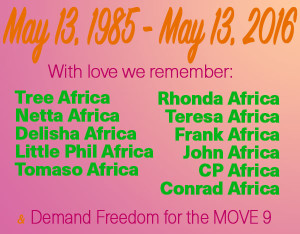
I’m scandalously late in posting this, but I could not let another year pass without including an acknowledgement of the horrific deaths of eleven members of the MOVE Organization on May 13, 1985, just over 31 years ago. Below, we have included a number of perspectives on what happened that day, from news agencies, activist blogs and the MOVE website. Finally, I’ve unearthed an interview I had done 16 years ago with several residents of Osage Avenue who, despite their opposition to the methods of MOVE, nonetheless raised questions that indicate that even people with some antipathy toward MOVE recognize the day of infamy that was May 13, 1985.
NPR
Why Have So Many People Never Heard Of The MOVE Bombing?
May 18, 20158:04 PM ET
Gene Demby
http://www.npr.org/sections/codeswitch/2015/05/18/407665820/why-did-we-forget-the-move-bombing
What gives? It’s seems incredible that so many people had never heard about the time American law enforcement bombed U.S. citizens on U.S. soil, which, on top of the deaths, left dozens of bystanders’ homes destroyed in an uncontrolled fire that the police commissioner told firefighters not to put out right away. The details are so extreme, so over-the-top. How have we forgotten this?
NewsOne
11 Things You Didn’t Know About The Time Police Bombed An American Neighborhood
http://newsone.com/3433351/11-things-you-didnt-know-about-move-philadelphia-bombing/
Free Thought Project
Today is the Anniversary of the One Terrorist Attack in America that You are Supposed to Forget
Claire Bernish
http://thefreethoughtproject.com/today-anniversary-terrorist-attack-america-supposed-forget/#irgSDRIeD2y0Kxfv.99
from a Wikipedia article on the MOVE Organization:
https://en.m.wikipedia.org/wiki/MOVE
In 1981 MOVE relocated to a row house at 6221 Osage Avenue in the Cobbs Creek area of West Philadelphia. After the move, neighbors complained for years that MOVE members were broadcasting political messages by bullhorn. However, the bullhorn was broken and inoperable for the three weeks prior to the bombing of the row house.
The police obtained arrest warrants charging four occupants with crimes including parole violations, contempt of court, illegal possession of firearms, and making terrorist threats. Mayor W. Wilson Goode and police commissioner Gregore J. Sambor classified MOVE as a terrorist organization. On May 13, 1985, the police, along with city manager Leo Brooks, arrived in force and attempted to clear the building and execute the arrest warrants. This led to an armed standoff with police, who lobbed tear gas canisters at the building. The police said that MOVE members fired at them; a gunfight with semi-automatic and automatic firearms ensued. Commissioner Sambor then ordered that the compound be bombed. From a Pennsylvania State Police helicopter, Philadelphia Police Department Lt. Frank Powell proceeded to drop two one-pound bombs (which the police referred to as “entry devices”) made of FBI-supplied water gel explosive, a dynamite substitute, targeting a fortified, bunker-like cubicle on the roof of the house.
The resulting explosions ignited a fire that eventually destroyed approximately 65 nearby houses. The firefighters, who had earlier deluge-hosed the MOVE members in a failed attempt to evict them from the building, stood by as the fire caused by the bomb engulfed the first house and spread to others, having been given orders to let the fire burn. Despite the earlier drenching of the building by firefighters, officials said that they feared that MOVE would shoot at the firefighters. Eleven people (John Africa, five other adults and five children aged 7 to 13) died in the resulting fire and more than 250 people were left homeless. Ramona Africa, one of the two survivors, stated that police fired at those trying to escape.
Fallout
Mayor Goode soon appointed an investigative commission called the PSIC (aka MOVE Commission), chaired by William H. Brown, III. Police commissioner Sambor resigned in November 1985, reporting that he felt that he was being made a “surrogate” by Goode. Goode, on the other hand, feared the Philadelphia Police Department as he had received intelligence indicating that he had been marked as a target for death by the police department. The MOVE Commission issued its report on March 6, 1986. The report denounced the actions of the city government, stating that “Dropping a bomb on an occupied row house was unconscionable.” Following the release of the report, Goode made a formal public apology. No one from the city government was charged criminally but the only surviving MOVE member, Ramona Africa, was charged and incarcerated on riot and conspiracy charges.
In 1996 a federal jury ordered the city to pay a US$1.5 million civil suit judgement to survivor Ramona Africa and relatives of two people killed in the bombing. The jury had found that the city used excessive force and violated the members’ constitutional protections against unreasonable search and seizure. Philadelphia was given the sobriquet “The City that Bombed Itself.”
from the MOVE Website (http://onmove.com):
Bombing Black People: The Philadelphia Police’s War on Move
March 3, 2016 by onamove
Global Research News Hour Episode 129
By Michael Welch and Linn Washington
January 31, 2016
http://onamove.com/bombing-black-people-the-philadelphia-polices-war-on-move/
My April 2000 Interview with Residents of Osage Avenue
This interview was conducted on April 29, 2000 with five residents of the Osage Avenue neighborhood which had been the scene of the May 13, 1985 bombing of the MOVE Organization. The interview has been edited for length, and the names of the interviewees were not recorded to ensure their privacy. The text had been saved on an old computer hard drive and was only recently recovered. For the full interview, click here.

